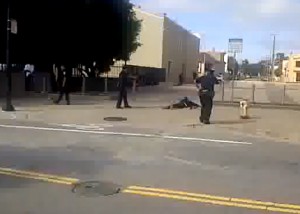Many web sites and media are pointing to a video of the aftermath of Kenneth Harding's shooting death by police in Bayview this past weekend. That video focuses mostly on the angry crowd reaction to the shooting, and has been cited by police as briefly showing a gun on the ground that police Harding had used to fire a shot at officers pursuing him.

But there's another video of the shooting out there taken from a different point of view and at an earlier point in time. (It's unclear whether the two were shot by the same person.) It shows a wounded Harding squirming on the ground as officers surround him with guns drawn. You can watch it here if you want, but before you do, please note that it is very graphic.
After watching the video, we wondered what sort of medical attention police typically render -- and when -- in a situation like this.
At the beginning of the video, a wounded Harding is already on the ground, several officers having closed in on him with guns drawn. As some police keep their weapons pointed and others attend to a crowd of bystanders, Harding remains on his stomach, bleeding, at times with his head lifted, at times with it down. At around 1:40 of the video, an officer approaches and bends down to attend to him, though what he's doing is unclear from the recording.
Harding was shot while fleeing police after being stopped at about 4:45 p.m. and was pronounced dead at San Francisco General Hospital about 7 p.m., police said. One user comment on a previous post we did was critical of the police for waiting to administer to Harding.
So what is the protocol for attending to a wounded suspect on the ground? At what point do police make the determination to move in and assist medically?